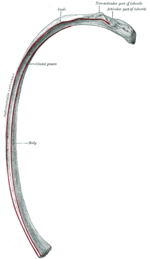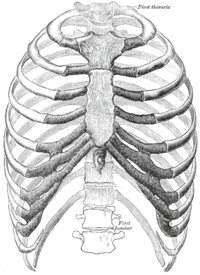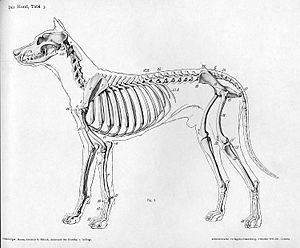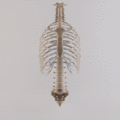Rib facts for kids
In animals with a backbone (called vertebrates), ribs are long, curved bones. They form the rib cage, which is part of the main skeleton that runs down the middle of your body. In most animals with four limbs, ribs surround the chest. This allows the lungs to expand and helps with breathing by making the chest cavity bigger. Ribs also protect important internal organs like the lungs and heart. In some animals, like snakes, ribs help support and protect their whole body.
Contents
Human Ribs: What Are They For?
Ribs are a type of flat bone. They are usually there to protect things inside the body. Humans have 24 ribs, arranged in 12 pairs. All ribs connect at the back to the thoracic vertebrae (bones in your upper back). They are numbered from 1 to 12 based on which vertebra they connect to. For example, the first rib connects to thoracic vertebra 1 (T1).
At the front of the body, most ribs join to the sternum (breastbone) using costal cartilages. These are flexible tissues that connect bones. Ribs connect to the vertebrae with two joints, called costovertebral joints.
Parts of a Rib
Each rib has several parts:
- The head is the end closest to the spine. It connects to the vertebrae.
- The neck is a flat part that extends from the head.
- The body (or shaft) is the main, curved part of the rib.
- A tubercle is a small bump on the back of the rib's neck. It also helps the rib connect to the vertebra.
- The angle is where the rib makes a sharp bend.
The Rib Cage: Your Body's Shield
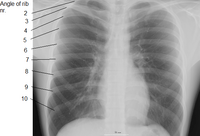
The first seven pairs of ribs are called "true ribs". They connect directly to the sternum (breastbone) with their own costal cartilages. The first rib is special. It's short, flat, and C-shaped. It's found just below the neck at the first thoracic vertebra. Ribs 2 through 7 look more typical and get longer and less curved as they go down.
The next five pairs are called "false ribs". Three of these share a common cartilage connection to the sternum. The last two pairs (ribs 11 and 12) are called "floating ribs". They only connect to the vertebrae at the back and do not connect to the sternum or other cartilage at the front.
Generally, human ribs get longer from rib 1 to rib 7, then get shorter again from rib 7 to rib 12. They also become more slanted from rib 1 to rib 9, then less slanted towards rib 12.
The rib cage is separated from the lower belly by a strong muscle called the thoracic diaphragm. This muscle is very important for breathing. When the diaphragm contracts (tightens), it pulls down, making the chest cavity bigger. This reduces the air pressure inside, which pulls air into your lungs. It's like a vacuum cleaner for your lungs!
Ribs in Other Animals
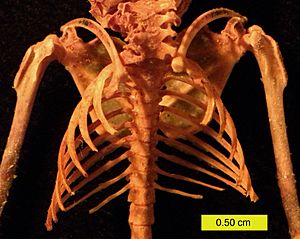
Animals have different kinds of ribs:
- In fish, there are often two sets of ribs. One set, called dorsal ribs, sticks out sideways. The other set, ventral ribs, are lower down and often join at their tips. Some fish only have one type, and some, like lampreys, have no ribs at all.
- Animals with four limbs (like mammals, birds, reptiles, and amphibians) usually have only one set of ribs. In early four-limbed animals, every vertebra had a pair of ribs.
- In living amphibians and reptiles, the number and shape of ribs vary a lot. For example, turtles have only eight pairs of ribs, which have grown into their hard shell (carapace and plastron). Snakes, on the other hand, have many ribs running along their whole body. Frogs usually have no ribs, except for a pair near their pelvis.
- In birds, ribs are only found in the chest area. Bird ribs also have a unique projection called an uncinate process, which helps attach shoulder muscles.
- Most mammals, including humans, only have distinct ribs in the chest area. Some mammals, like dogs, usually have 26 ribs. Unlike reptiles, mammals never have ribs in their tail area.
Ribs as Food
Ribs are a popular food from many animals. They are the less meaty part of a meat chop. Ribs are often cooked as a whole "slab" or "rack," which means five or more ribs together, like a rack of lamb. Short ribs are beef ribs, served either alone or several as a "plate." A rib steak from beef is also a popular choice in many types of cooking. Pork ribs, including spare ribs, are very popular in European and Asian cooking.
Images for kids
See also
 In Spanish: Costilla para niños
In Spanish: Costilla para niños


